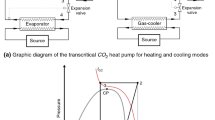Abstract
Conventional exergy analysis identifies component exergy destruction, however, does not give clear picture whether occurs because of component itself or due to remaining components and then the advanced exergy analysis is emphasized. The main purpose of this study is to apply advanced exergy analysis to the transcritical CO2 vapor compression heat pump system for simultaneous water cooling and heating, along with the conventional exergy analysis. The novelty of the present study is the advanced exergy analysis (with modified methodology) of transcritical superheat cycle based on experimental data. Endogenous, exogenous, avoidable and unavoidable exergy destructions are determined for each component of this system. Results show that compressor is having highest exergy destruction among the CO2 system components and also its major part is avoidable endogenous exergy destruction. According to conventional exergy analysis, the sequence for improvement seems to be compressor, gas cooler, expansion valve and evaporator; however, the in-depth analysis (advanced exergy analysis) shows compressor is the first component followed by evaporator, gas cooler and expansion valve to be considered for improvisation. Thus it is concluded that compressor provides highest opportunity for improvement and new design of the same will improve overall transcritical CO2 system performance.








Similar content being viewed by others
References
Morosuk T and Tsatsaronis G 2006 Splitting the exergy destruction into endogenous and exogenous parts—Application to refrigeration machines. In: Proceedings of the 19th international conference on efficiency, cost, optimization, simulation and environmental impact of energy systems, July 12–14, AghiaPelagia: Crete, Greece, 165–172
Morosuk T and Tsatsaronis G 2008 New approach to the exergy analysis of absorption refrigeration machines. Energy Int. J. 31: 890–907
Kelly S, Tsatsaronis G and Morusuk T 2009 Advanced exergetic analysis: Approaches for splitting the exergy destruction into endogenous and exogenous parts. Energy Int. J. 34: 384–391
Morosuk T and Tsatsaronis G 2009 Advanced exergetic evaluation of refrigeration machines using different working fluids. Energy Int. J. 34: 2248–2258
Erbay Z and Hepbasli A 2013 Advanced exergy analysis of a heat pump drying system used in food drying. Drying Technol. 31: 802–810
Mosaffa A H, Farshi L, Ferriera C A I and Rosen M A 2014 Advanced exergy analysis of an air conditioning system incorporating thermal energy storage. Energy Int. J. 77: 945–952
Gong S and Boulama K G 2014 Parametric study of an absorption refrigeration machine using advanced exergy analysis. Energy 76: 453–467
Mehrpooya M and Ansarinasab H 2015 Advanced exergoeconomic analysis of the multistage mixed refrigerant systems. Energy Convers. Manag. 103: 705–716
Sarkar J, Bhattacharyya S and Ramgopal M 2009 A transcritical CO2 heat pump for simultaneous water cooling and heating: test results and model validation. Int. J. Energy Res. 33: 100–109
Tao Y B, He Y L and Tao WQ 2010 Exergetic analysis of transcritical CO2 residential air-conditioning system based on experimental data. Appl. Energy 87: 3065–3072
Aprea C, Greco A and Maiorino A 2013 The substitution of R134a with R744: An exergetic analysis based on experimental data. Int. J. Refrig. 36: 2148–2159
Ma J, Liu C, Zhou Q, Chen X and Hou Y 2014 Experimental investigation for effects of electronic expansion valve opening on exergy loss in transcritical CO2 system. J. Xi’an Jiaotong Univ. 48: 12–16
Tsatsaronis G and Morosuk T 2012 Advanced thermodynamic (exergetic) analysis. J. Phys. Conf. Ser. 395: 012160
Author information
Authors and Affiliations
Corresponding author
Appendices
Nomenclatures
- p:
-
pressure (MPa)
- T:
-
temperature (K)
- \( {\dot{\text{E}}} \) :
-
exergy rate (kW)
- e:
-
specific exergy (kJ/kg)
- \( {\dot{\text{m}}} \) :
-
mass flow rate (kg/s)
- h:
-
specific enthalpy (kJ/kg)
- s:
-
specific entropy (kJ/kg K)
- sgen :
-
specific entropy generation (kJ/kg K)
- ε:
-
exergetic efficiency
- \( {\dot{\text{W}}} \) :
-
power (kW)
- \( \Delta T_{\hbox{min} } \) :
-
pinch point temperature difference (K)
Subscripts
- CM:
-
compressor
- GC:
-
gas cooler
- TV:
-
throttling valve
- EV:
-
evaporator
- k:
-
kth component
- 0:
-
property at dead state
- f:
-
fuel
- d:
-
destruction
- p:
-
product
- tot:
-
overall system
- l:
-
losses
- x:
-
property at (T0, p)
Superscripts
- AV:
-
avoidable
- EN:
-
endogenous
- EX:
-
exogenous
- UN:
-
unavoidable
Rights and permissions
About this article
Cite this article
Sarkar, J., Joshi, D. Advanced exergy analysis of transcritical CO2 heat pump system based on experimental data. Sādhanā 41, 1349–1356 (2016). https://doi.org/10.1007/s12046-016-0555-y
Received:
Revised:
Accepted:
Published:
Issue Date:
DOI: https://doi.org/10.1007/s12046-016-0555-y



